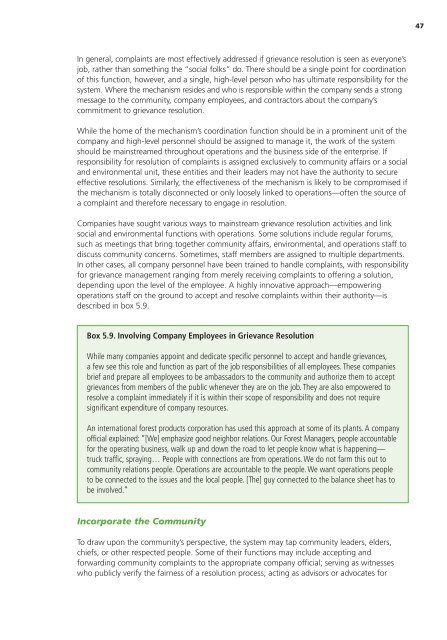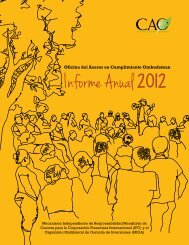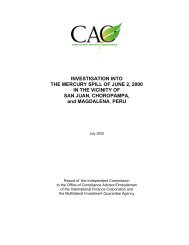A Guide to Designing and Implementing Grievance Mechanisms for ...
A Guide to Designing and Implementing Grievance Mechanisms for ...
A Guide to Designing and Implementing Grievance Mechanisms for ...
Create successful ePaper yourself
Turn your PDF publications into a flip-book with our unique Google optimized e-Paper software.
In general, complaints are most effectively addressed if grievance resolution is seen as everyone’s<br />
job, rather than something the “social folks” do. There should be a single point <strong>for</strong> coordination<br />
of this function, however, <strong>and</strong> a single, high-level person who has ultimate responsibility <strong>for</strong> the<br />
system. Where the mechanism resides <strong>and</strong> who is responsible within the company sends a strong<br />
message <strong>to</strong> the community, company employees, <strong>and</strong> contrac<strong>to</strong>rs about the company’s<br />
commitment <strong>to</strong> grievance resolution.<br />
While the home of the mechanism’s coordination function should be in a prominent unit of the<br />
company <strong>and</strong> high-level personnel should be assigned <strong>to</strong> manage it, the work of the system<br />
should be mainstreamed throughout operations <strong>and</strong> the business side of the enterprise. If<br />
responsibility <strong>for</strong> resolution of complaints is assigned exclusively <strong>to</strong> community affairs or a social<br />
<strong>and</strong> environmental unit, these entities <strong>and</strong> their leaders may not have the authority <strong>to</strong> secure<br />
effective resolutions. Similarly, the effectiveness of the mechanism is likely <strong>to</strong> be compromised if<br />
the mechanism is <strong>to</strong>tally disconnected or only loosely linked <strong>to</strong> operations—often the source of<br />
a complaint <strong>and</strong> there<strong>for</strong>e necessary <strong>to</strong> engage in resolution.<br />
Companies have sought various ways <strong>to</strong> mainstream grievance resolution activities <strong>and</strong> link<br />
social <strong>and</strong> environmental functions with operations. Some solutions include regular <strong>for</strong>ums,<br />
such as meetings that bring <strong>to</strong>gether community affairs, environmental, <strong>and</strong> operations staff <strong>to</strong><br />
discuss community concerns. Sometimes, staff members are assigned <strong>to</strong> multiple departments.<br />
In other cases, all company personnel have been trained <strong>to</strong> h<strong>and</strong>le complaints, with responsibility<br />
<strong>for</strong> grievance management ranging from merely receiving complaints <strong>to</strong> offering a solution,<br />
depending upon the level of the employee. A highly innovative approach—empowering<br />
operations staff on the ground <strong>to</strong> accept <strong>and</strong> resolve complaints within their authority—is<br />
described in box 5.9.<br />
Box 5.9. Involving Company Employees in <strong>Grievance</strong> Resolution<br />
While many companies appoint <strong>and</strong> dedicate specific personnel <strong>to</strong> accept <strong>and</strong> h<strong>and</strong>le grievances,<br />
a few see this role <strong>and</strong> function as part of the job responsibilities of all employees. These companies<br />
brief <strong>and</strong> prepare all employees <strong>to</strong> be ambassadors <strong>to</strong> the community <strong>and</strong> authorize them <strong>to</strong> accept<br />
grievances from members of the public whenever they are on the job. They are also empowered <strong>to</strong><br />
resolve a complaint immediately if it is within their scope of responsibility <strong>and</strong> does not require<br />
significant expenditure of company resources.<br />
An international <strong>for</strong>est products corporation has used this approach at some of its plants. A company<br />
official explained: “[We] emphasize good neighbor relations. Our Forest Managers, people accountable<br />
<strong>for</strong> the operating business, walk up <strong>and</strong> down the road <strong>to</strong> let people know what is happening—<br />
truck traffic, spraying… People with connections are from operations. We do not farm this out <strong>to</strong><br />
community relations people. Operations are accountable <strong>to</strong> the people. We want operations people<br />
<strong>to</strong> be connected <strong>to</strong> the issues <strong>and</strong> the local people. [The] guy connected <strong>to</strong> the balance sheet has <strong>to</strong><br />
be involved.”<br />
Incorporate the Community<br />
To draw upon the community’s perspective, the system may tap community leaders, elders,<br />
chiefs, or other respected people. Some of their functions may include accepting <strong>and</strong><br />
<strong>for</strong>warding community complaints <strong>to</strong> the appropriate company official; serving as witnesses<br />
who publicly verify the fairness of a resolution process; acting as advisors or advocates <strong>for</strong><br />
47





